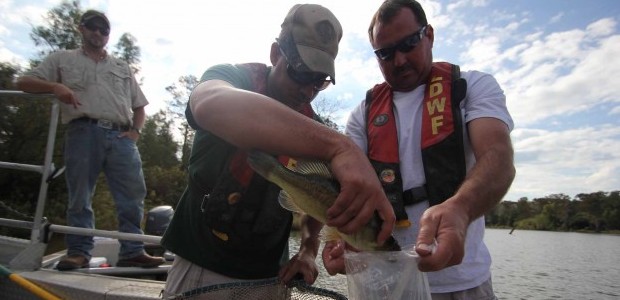Terrebonne school term limits, parish, fire millages on ballot
October 23, 2012Our View: Justice pick offers court’s example
October 23, 2012Atchafalaya Basin anglers may see the end of the largemouth bass 14-inch minimum length limit that has stood since basin bass populations were decimated after Hurricane Andrew in 1992.
“The Atchafalaya Basin is not a good candidate for a size limit,” said Louisiana Department of Wildlife and Fisheries director of inland fisheries Mike Wood. “The Atchafalaya Basin bass population will continue to produce the same number of nice size bass, with or without the 14-inch length limit.”
The Louisiana Department of Wildlife and Fisheries recently released a report on the 14-inch limit and its effectiveness as a management tool. During the study, LDWF inland fisheries staff looked at environmental disturbances, such as hurricanes Andrew, Lili, Rita and Gustav and the 1998 drought, and determined that the bass population in the basin, including Lakes Verret, Palourde and Fausse Pointe, is more heavily influenced by these events than anglers.
“The basin has a close connection with the Gulf and storms, and this is the same reason that the regulation can’t work,” Wood said. “The basin is a unique ecosystem. Bass there grow slowly, far slower than the state average, and don’t live long. This regulation cannot achieve a long-term result – producing larger bass. Anglers have the best intentions, to catch and release, but they are releasing these fish just to watch them die. There is great fishing and plenty of fish to catch in the basin, but not that many big bass.”
An estimated 200 million fish in the basin were left dead following Hurricane Andrew, and the LDWF later restocked the area’s waterways and imposed the 14-inch minimum length limit for bass for the following two years, protecting the stocked fish until they could spawn once or twice and replenish the population naturally.
“The Atchafalaya Basin fishery rebounded quickly after Andrew, and many credited the regulation as the primary factor for the recovery,” Wood said. “There was also optimism among anglers and biologists that the regulation might increase the number of large bass in the basin. In the early 1990s, there was a lot of talk amongst basin anglers about wanting to make the basin a big bass spot. Lakes in Texas were producing big bass. Anglers wanted that here, but over time, the 14-inch regulation shaped into something else – a larger number of bass and a larger catch rate.”
Prior to Hurricane Andrew, the Atchafalaya Basin was the top freshwater fishing spot in the state according to a Louisiana State University survey of Louisiana recreational anglers. Anglers were catching an average of 4.93 fish per trip and harvesting 1.39 fish per trip.
“It’s in between two metro areas, so it’s still very popular,” Wood said. “It’s also seasonal. When the fishing is on, it’s on. When the water is low, people flock there. It gets lots of use.”
Following Hurricane Andrew, anglers were only catching about 2.35 fish per trip and harvesting .20 fish. By 1996, fishing had rebounded, and anglers were catching 5.38 fish per trip and harvesting 0.86 fish. Angler expectations of the basin becoming a big bass spot were on the rise until hits from hurricanes Lili and Gustav left many of the protected fish dead, and the strong initial public support for the 14-inch minimum began to wane.
As LDWF began to take a closer look at the 14-inch minimum limit, it was discovered that largemouth bass in the basin take an average of 3.4 years to reach the minimum length limit, and with catastrophic events hitting the basin roughly every three to six years, most fish did not make it to the minimum length limit.
“Those that reach the 14-inch mark are well over 3 years old,” Wood said. “Basin bass also have short life spans, with few living past the age of 5. Slow growth and short life spans aren’t necessarily bad; they come with the territory in the Atchafalaya Basin. The basin still has a very healthy bass population, but the combination of slow growth and short life spans lends to smaller bass.”
In addition to storms slowing the growth of the bass, the staple food of the basin bass diet also plays a part in growth rates.
“Crawfish are the primary food source for bass in the Atchafalaya Basin,” Wood said. “Crawfish are not high in protein, and that is what is needed for fast and large growth.”
Wood declined to say whether droughts or storms are worse for the basin bass population, but did say that both were catastrophic to the fish populations.
“Floods can also be negative for the fish population,” he added.
Over the next several months, LDWF will conduct angler opinion surveys before making any decisions regarding the 14-inch regulation.
“We want to know what sportsman want out of basin,” Wood said. “I hope that anglers will agree that the minimum length limit is not useful, and we will remove the regulation.”
Some anglers for, against the regulation
Sean Robbins, president of the Lake Verret Bass Club and resident of Baton Rouge, has been fishing the basin for more than 30 years and supports the proposal to change the minimum length limit.
“Maybe change the creel limit – keep a certain number over a certain size and a certain number of fish of any size, like five of this any size and five over 14 inches,” Robbins said. “You take too many trips and all you catch are fish that are too small to keep. They need to do something to get the small population size down and give some of these fish a chance to get bigger.”
In the years since Hurricane Andrew roared over the basin, Robbins’ largest catch has been a 4.5-pound bass.
“Andrew was the worst storm,” Robbins recalled. “It was a while after that storm before you caught anything. I have a friend who caught a 7.10-pound fish in the basin in the last few years, but you can go out there and catch 50 fish in a day and not get a single keeper. There still needs to be some type of limit, but the size needs to change. Fishing is good, and you could fill up an ice chest if the limit was lowered. I don’t want a new regulation to drop the fish population down too far, but they just need to do something where people can bring home fish.”
Robbins also hoped that allowing anglers to take more bass would result in less competition for food amongst the rest of the fish population.
Fellow bass club member and club treasurer Brad Rodrigue of Pierre Part would like to see the current limit stand.
“Biologists from LDWF talk about the health of the basin bass population, so why change it?” Rodrigue asked. “You catch a lot of undersized fish, but that is just part of the fishery. You may just get one keeper the whole day. Biologists will tell you that smaller bass are more aggressive and easier to catch. The bigger bass are less aggressive and harder to catch. It’s not uncommon for bass fishing to be that way.”
Rodrigue has been fishing the basin since early 1980s, a time when he says bass fishing in the area was just starting to decline and roughly 10 years before Hurricane Andrew made things even worse.
“After Andrew, LDWF restocked the basin and set the limit,” he said. “I’d like to see them keep it. I think the fishery is healthy, but I also think Louisiana has the worst managed fisheries in the country. Wildlife and Fisheries can only do so much because the department has been stripped of so much funding with the budget cuts. I’m really aggravated and frustrated, but they can only do so much with what they have.”
In addition to fishing the basin – mostly the area between Bayou Sorrel and Morgan City on the southeast side – Rodrigue also fishes lakes in Texas, Alabama, Mississippi, South Carolina, Georgia and Florida.
“If they change the laws, in five years people will be complaining that they are only catching 12-inch bass,” Rodrigue said. “I hear that’s what some people want to see it changed to. All the 14-inch fish will be gone. It’s a weight and balance system. People will catch fish to start with, but the population will deplete.”
According to Rodrigue, spring – the time of the year when bass are on the beds – is the most detrimental time for fish in the basin.
“People will catch 3- to 4-pound fish that are full of eggs,” Rodrigue said. “These bass need to distribute the eggs to help replenish the population. In the last 20 years, I haven’t caught any fish over five pounds. Every now and then you hear about one over 5 pounds, but not often.”
Staff from the Louisiana Department of Wildlife and Fisheries inland fisheries division collect fish from electrofishing sampling in the Atchafalaya Basin. The LDWF is seeking angler opinions on lowering the 14-inch minimum length limit for largemouth bass in the basin.











